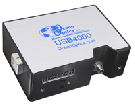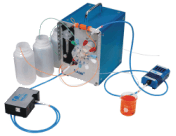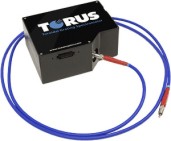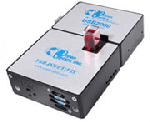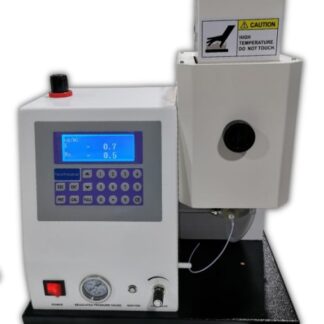Description
- The USB4000 is the last-generation flagship spectrometer, with a 3648-element Toshiba linear CCD array for increased signal-to-noise and enhanced electronics for controlling the spectrometer and accessories.
- The Integration Time setting in our software is specified by the user. It’s analogous to the shutter speed of a camera: the value specified for the integration time is the amount of time the detector “looks” at the incoming photons. Because the Toshiba detector has an electronic shutter, using software you can specify minimum integration times as short as 10 µs, allowing you to measure transient events like laser pulses. The ability to integrate the spectrometer for brief durations eliminates saturation problems that can occur in high light-level applications such as laser analysis.
- The USB4000’s onboard programmable microcontroller provides you with considerable flexibility in controlling the spectrometer and accessories. Through a 22-pin connector, you can implement all operating parameters in the software: control light sources, create processes, and retrieve information on external objects. You have access to 8 user-programmable digital Inputs/Outputs for interfacing to other equipment.
- The USB4000 provides you with an affordable, high-performance 3648-element linear CCD-array detector with an optical bench that’s small enough to fit into the palm of your hand. The USB4000 works the same way as other Ocean Optics spectrometers; it accepts light energy transmitted through single-strand optical fiber and disperses it via a fixed grating across the linear CCD array detector, which is responsive from 200-1100 nm.
- At Ocean Optics, we understand that your work is unique and that you want a spectrometer to fit your specific needs. Working with one of our application scientists, we help you determine which configuration will best work for you. When selecting the USB4000 — you can choose from 14 gratings, 6 slits and hundreds of fiber optic accessories such as light sources, probes and optical fibers to create the optimal system for your application.
- When you purchase a USB4000, you can also choose from Ocean Optics’ complete line of spectroscopic accessories. Most accessories have SMA 905 connectors for application flexibility. Changing the sampling system is as easy as unscrewing a connector and adding new components or accessories, such as light sources, sampling holders, filter holders, flow cells, fiber optic probes and sensors, collimating lenses, attenuators, diffuse reflectance standards, integrating spheres and our extensive line of optical fibers.
- To properly configure a USB4000 Spectrometer for your application, you’ll need to specify one of the detector options listed in the table below.
DET4-200-850 sorting filter 200-850 nm DET4-350-1000 sorting filter 300-1000 nm DET4-UV UV upgrade DET4-VIS VIS - The USB4000 interfaces to a PC, PLC or other embedded controllers via USB 2.0 or RS-232 serial port. Data unique to each spectrometer is programmed into a memory chip on the USB4000; our spectrometer operating software reads these values for easy setup and hot swapping among PCs.
- Serial port operation tips: When using the serial port, the USB4000 requires a single 5-volt power supply (not included). Also, SpectraSuite Spectroscopy Software does not support spectrometer operation via the serial port. However, using the included Serial Port Command Set, you can write your own software that makes serial port operation possible.
- For on line mesaurement
Spécifications
- Dimensions: 89.1 mm x 63.3 mm x 34.4 mm
- Weight: 190 grams
- Toshiba TCD1304AP Linear CCD array
- Detector range: 200-1100 nm
- Pixels: 3648 pixels
- Pixel size: 8 um x 200 um
- Pixel well depth: 100,000 electrons
- Signal-to-noise ratio: 300:1 (at full signal)
- A/D resolution: 16 bit
- Dark noise: 12 RMS counts
- Corrected linearity: >99.8%
- Sensitivity: 130 photons/count at 400 nm; 60 photons/count at 600 nm
- Optical Bench Design: f/4, Asymmetrical crossed Czerny-Turner
- Focal length: 42 mm input; 68 mm output
- Entrance aperture: 5, 10, 25, 50, 100 or 200 µm wide slits or fiber (no slit)
- Grating options: 14 different grating options, UV through Shortwave NIR
- HC-1 grating option: No
- Detector collection lens option: Yes, L4
- OFLV filter options: OFLV-200-850; OFLV-350-1000
- Other bench filter options: Longpass OF-1 filters
- Collimating and focusing mirrors: Standard or SAG+UPG
- UV enhanced window: Yes, UV4
- Fiber optic connector: SMA 905 to 0.22 numerical aperture single-strand optical fiber
- Wavelength range: Grating dependent
- Optical resolution: ~0.3-10.0 nm FWHM
- Signal-to-noise ratio: 300:1 (at full signal)
- A/D resolution; 16 bit
- Dark noise: 24 RMS counts
- Integration time: 10 µs to 65 seconds
- Dynamic range: 2 x 108 (system), 1300:1 for a single acquisition
- Stray light: <0.05% at 600 nm; 0.10% at 435 nm
- Power consumption: 250 mA @ 5 VDC
- Data transfer speed: Full spectrum to memory every 4 ms with USB 2.0 port, 18 ms with USB 1.1 port
- Inputs/Outputs: Yes, 8 onboard digital user-programmable GPIOs
- Analog channels: No
- Auto nulling: Yes
- Breakout box compatible: Yes, USB4-BREAKOUT
- Trigger modes: 5 modes
- Strobe functions: Yes
- Connector: 22-pin connector
- Operating systems: Windows 98/Me/2000/XP, Mac OS X and Linux with USB port; Any 32-bit Windows OS with serial port
- Computer interfaces: USB 2.0 @ 480 Mbps (USB1.1 compatible); RS-232 (2-wire) @ 115.2 K baud
- Peripheral interfaces: SPI (3-wire); I2C inter-integrated circuit
